IV Congreso Iberoamericano de Seguridad Informática (CIBSI’07), Sebastián Cañón, M.A., pp. 111-124, 2007.
V Congreso Iberoamericano de Seguridad Informática (CIBSI’09), Universidad de la República, Uruguay, pp. 409-423, 2009.
Abstract
Grid móvil incluye las características de los sistemas Grid junto conlas peculiaridades de la computación móvil, añadiendo la propiedad de soportarusuarios y recursos móviles de forma homogénea, transparente, segura yeficiente. La seguridad de estos sistemas, debido a su naturaleza abierta ydistribuida, es un tema de gran interés. Una arquitectura de seguridad basada enSOA proporciona una arquitectura distribuida diseñada para interoperabilidadde servicios, fácil integración, y acceso seguro, simple y extensible. Por tanto,una arquitectura orientada a servicios de seguridad es construida para entornosGrid móviles, ofreciendo servicios de seguridad a usuarios móviles quienesusan servicios Grid y recursos para ejecutar sus trabajos y tareas. Estaarquitectura es integrada con otras arquitecturas existentes proporcionandomayor seguridad y permitiendo que los usuarios móviles puedan acceder aservicios Grid existentes ofreciendo nuevos y necesarios servicios de seguridadpara Grid móviles. Hemos definido un conjunto de servicios de seguridad, quejunto a protocolos, políticas y estándares de seguridad forman una arquitecturade seguridad orientada a servicios para entornos Grid móviles. Esta arquitecturaes abierta, escalable, dinámica, interoperable y flexible.
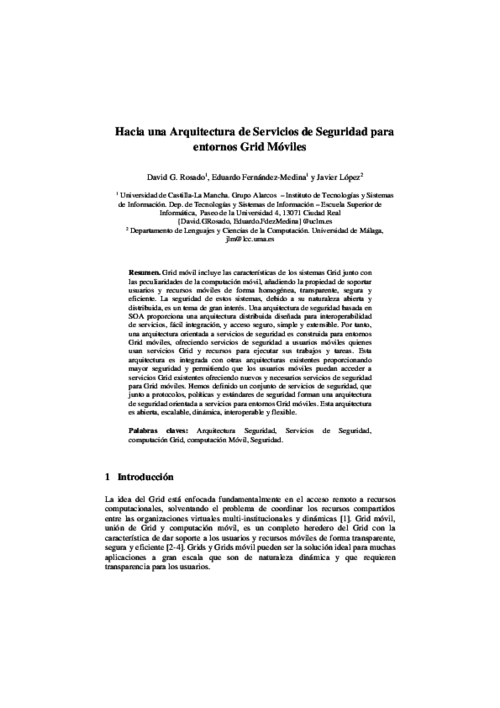
Wireless Sensor Network Security, J. Lopez, and J. Zhou Eds., IOS Press, 2008.
Abstract
Security has been proven a crucial factor in the provision of data services and especially in the computer-related environments. While wired and wireless networks come to all sectors of everyday life, security tries to satisfy the growing needs for confidentiality, integrity and non-repudiation. There are many instances of security primitives and each one of them has different requirements in terms of processing power, word size, etc. Therefore, it is important to review the functionality of the less resource-demanding encryption algorithms in order to analyze their theoretical suitability to the existent sensor node hardware. Still, the constraints inherent to the sensor nodes advise against the total dependence on software-based implementations, even more in the case of expensive primitives.
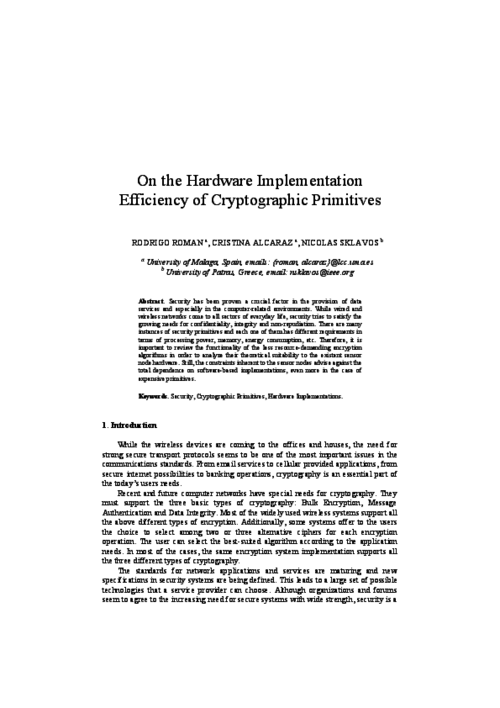
Proceedings of the 27th IFIP TC 11 International Information Security and Privacy Conference (SEC 2012), D. Gritzalis, S. Furnell, and M. Theoharidou Eds., IFIP AICT 376, Springer Boston, pp. 162-173, June 2012. DOI
Abstract
Covert channels are a form of hidden communication that may violate the integrity of systems. Since their birth in multilevel security systems in the early 70’s they have evolved considerably, such that new solutions have appeared for computer networks mainly due to vague protocols specifications. We analyze a protocol extensively used today, the Dynamic Host Configuration Protocol (DHCP), in search of new forms of covert communication. From this analysis we observe several features that can be effectively exploited for subliminal data transmission. This results in the implementation of HIDE_DHCP, which integrates three covert channels that accommodate to different stealthiness and bandwidth requirements

XIII Reunión Española sobre Criptología y Seguridad de la Información (RECSI 2014), pp. 303-308, 09/2014.
Abstract
El análisis conjunto de mecanismos de seguridad y QoS es esencial para las redes heterogéneas donde diversos dispositivos pueden coexistir en entornos dinámicos. En concreto, los dispositivos no siempre pueden ser conocidos, por lo que diferentes requisitos y mecanismos pueden surgir para el análisis. En este artículo, proponemos una herramienta para facilitar la configuración de entornos basada en el análisis paramétrico de dependencias, tomando como base de conocimiento un conjunto de parámetros de seguridad y QoS. Esta forma de análisis de parámetros a alto nivel permite considerar las dependencias y la compensación entre mecanismos con independencia del sistema de información subyacente. Posibilita por tanto evaluar el impacto que tales mecanismos, y otros definidos acorde al modelo, tienen sobre un sistema previo a su despliegue.
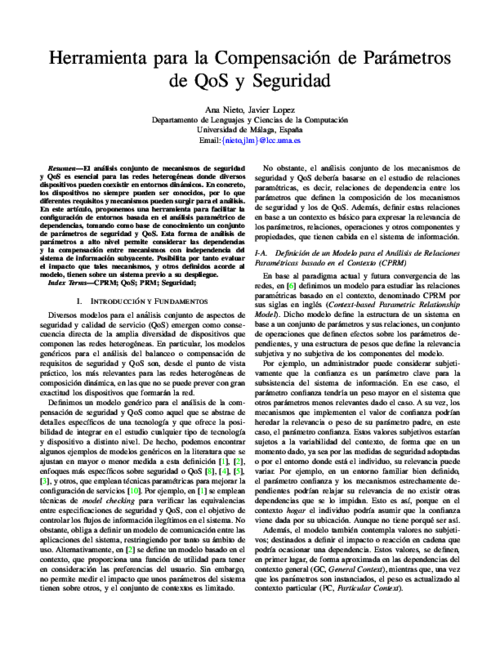
7th IFIP Conference on Multimedia and Communications Security (CMS’03), LNCS 2828, Springer-Verlag, pp. 158-171, October, 2003.
Abstract
Security services are essential for ensuring secure communications. Typically no consideration is given to security requirements during the initial stages of system development. Security is only added latter as an afterthought in function of other factors such as the environment into which the system is to be inserted, legal requirements, and other kinds of constraints. In this work we introduce a methodology for the specification of security requirements intended to assist developers in the design, analysis, and implementation phases of protocol development. The methodology consists of an extension of the ITU-T standard requirements language MSC and HMSC, called SRSL, defined as a high level language for the specification of security protocols. In order to illustrate it and evaluate its power, we apply the new methodology to a real world example, the integration of an electronic notary system into a web-based multi-users service platform.
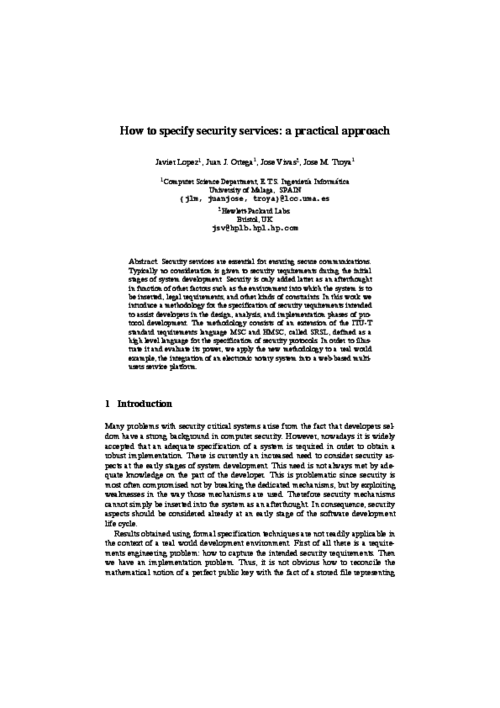
IEEE Globecom 2003 - Communications Security Track, IEEE Press, pp. 1506-1510, December, 2003.
Abstract
In order to study the security systems, we have developed a methodology for the application to the analysis of cryptographic protocols of the formal analysis techniques commonly used in communication protocols. In particular, we have extended the design and analysis phases with security properties. Our proposal uses a specification notation based on HMSC/MSC, which can be automatically translated into a generic SDL specification.
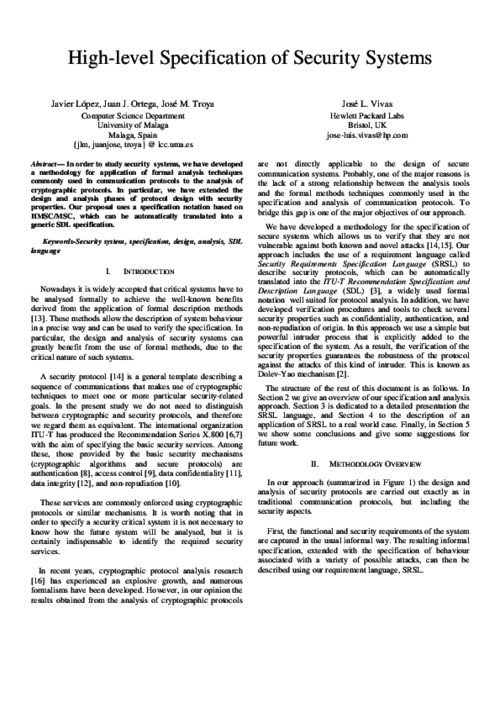
Novática, vol. 145, pp. 65-71, 2000.
Abstract
El comercio electrónico está llamado a ser el fenómeno de mayor importancia en el futuro de Internet. Entre sus aplicaciones se encuentran las compras en línea, la banca electrónica, la tele-educación, los casinos virtuales, los servicios de pago por visión y vídeo bajo demanda, etc. Desde el punto de vista de la Seguridad, estas aplicaciones presentan una serie de nuevos requisitos que van a imponer un gran esfuerzo investigador a corto y medio plazo. En este artículo se presentan algunos de los más importantes, como la administración de la confianza, la utilización de pagos electrónicos, la necesidad de la protección de la propiedad intelectual, los servicios de protección de privacidad y anonimato, y la autonomía de código y la detección de fraudes, identificándose las áreas de investigación relacionadas.
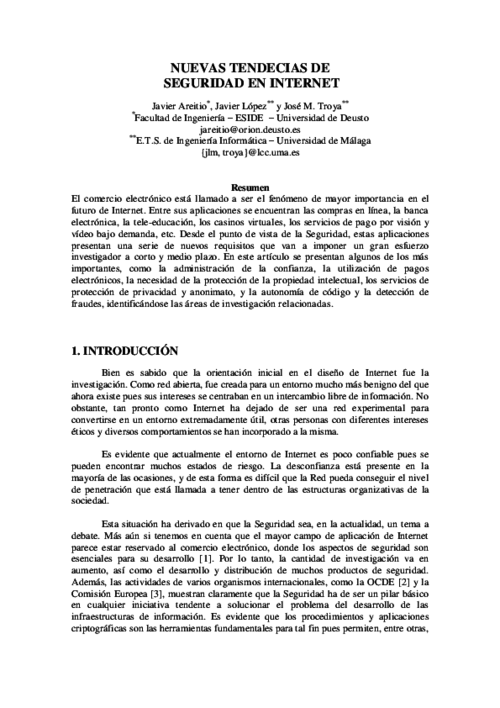
 ]
]